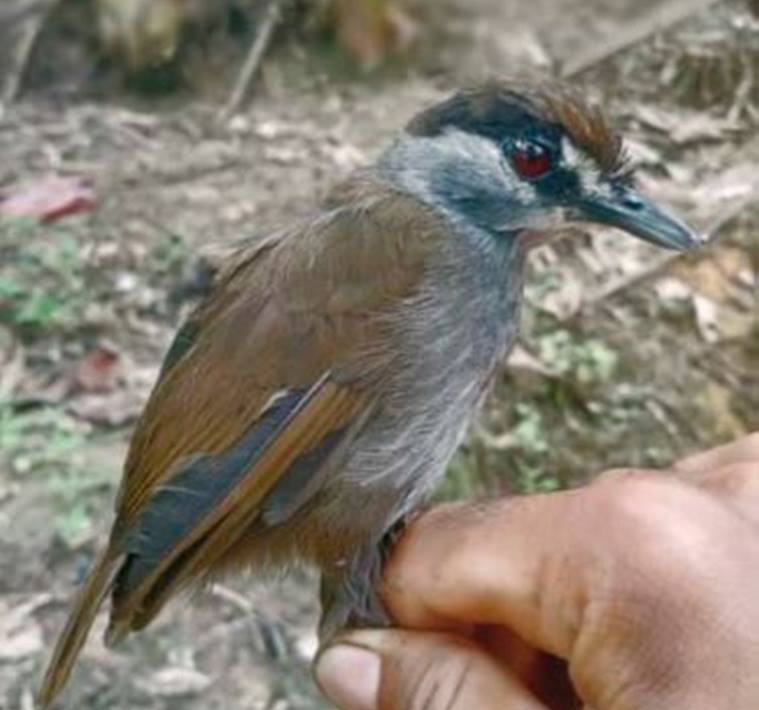Some time between 1843 and 1848, a German naturalist by the name of Carl Schwaner, trekking through the dense equatorial forests of Borneo, came across a small brown-grey songbird with a distinctive broad, black eye-stripe running all the way around its head.
For more than 170 years after that reporting, this single specimen represented the only recorded sighting of this bird species — the species holotype is now at the Naturalis Biodiversity Center in Leiden, Netherlands. Until late last year.
Return of the babbler
On October 5, 2020, a solitary black-browed babbler (Malacocincla perspicillata) was spotted and captured alive by two local residents in southeastern Kalimantan, the part of Borneo that is administered by Indonesia. The finding was reported on February 25 in BirdingASIA, the biannual bulletin of the Oriental Bird Club.
“No Asian bird has been missing for as long as Indonesia’s Black-browed Babbler Malacocincla perspicillata,” the authors of the short paper wrote. [‘Missing for 170 years — the rediscovery of Black-browed Babbler Malacocincla perspicillata on Borneo’: BirdingASIA 34 (2020); Panji Gusti Akbar et al.]
“On 5 October 2020, we observed a live specimen of the Black-browed Babbler in south-east Kalimantan, the first sighting of this species for 170 years. The bird was obtained by two local residents after being observed several times during their daily visits to the forest. Based on photographs taken of the bird during its temporary captivity (before its eventual release back into the wild), we took detailed notes.”
Akbar, the lead author of the paper who is an ornithologist with the tourism company Birdpacker Indonesia, told reporters that he received a picture of the bird by WhatsApp and, after going through his field guides, found it matched the black-browed babbler. It was such a shock that he could not initially believe what he was seeing.
“I contacted as many leading ornithologists as possible, and they all agreed that there is no other bird that [it] looks [like] other than a black-browed babbler,” Akbar told the US-based conservation and environment-focussed nonprofit news platform Mongabay. “It just blew my mind.”
Appearance of the bird
Akbar and his colleagues wrote that the bird was stout, with a “relatively short tail and a robust bill” similar to the holotype. “The upper parts were rich brown, while the underparts up to the breast were greyish with fine white streaking. The facial appearance of the bird was very distinct, with the crown being chestnut-brown, demarcated by a broad, black eye-stripe extending across the malars to the nape and neck-sides… The irides were deep red and unlike the holotype, which has been given artificial yellowish eyes. The legs were dark slate-grey…”
 Black-browed Babbler Malacocincla perspicillatum, unseen for 170 years, South Kalimantan, Indonesian Borneo, October 2020. (Photo credit: Muhammad Rizky Fauzan, from the paper Missing for 170 years — the rediscovery of Black-browed Babbler Malacocincla perspicillata on Borneo’: BirdingASIA 34 (2020); Panji Gusti Akbar et al.)
Black-browed Babbler Malacocincla perspicillatum, unseen for 170 years, South Kalimantan, Indonesian Borneo, October 2020. (Photo credit: Muhammad Rizky Fauzan, from the paper Missing for 170 years — the rediscovery of Black-browed Babbler Malacocincla perspicillata on Borneo’: BirdingASIA 34 (2020); Panji Gusti Akbar et al.)
Akbar told Mongabay that they suspected “this bird might actually have been around this area for quite a long time… It’s just that there is nobody coming to see them…nobody who knows how to identify birds.”
No data on numbers
It is possible in fact, that there are other individuals of the species in the jungles of Indonesia — a report in The New York Times on the rediscovery of the black-browed babbler said that local men Muhammad Suranto and Muhammad Rizky Fauzan “were curious about the identity of a black and brown bird they sometimes saw flitting around during their trips into the forest in South Kalimantan”, and had finally “managed to catch one of the birds and text photos to Joko Said Trisiyanto, a member of BW Galeatus”, a bird-watching group that was formed in Indonesian Borneo in 2016. It was Trisiyanto who passed the photos to Akbar.
That said, however, absolutely nothing is known of the size of this population — if there is one. The conservation status of the species is listed in the “Data Deficient” category in the IUCN red list. IUCN says “the global population size has not been quantified, but the species is described as possibly extinct and known only from a single specimen”, based on del Hoyo et al., 2007.
"bird" - Google News
March 03, 2021 at 11:03AM
https://ift.tt/3bRSke5
Explained: How, after 170 years, a ‘lost’ bird was found in the jungles of Indonesian Borneo - The Indian Express
"bird" - Google News
https://ift.tt/2s1zYEq
https://ift.tt/3dbExxU
Bagikan Berita Ini
















0 Response to "Explained: How, after 170 years, a ‘lost’ bird was found in the jungles of Indonesian Borneo - The Indian Express"
Post a Comment